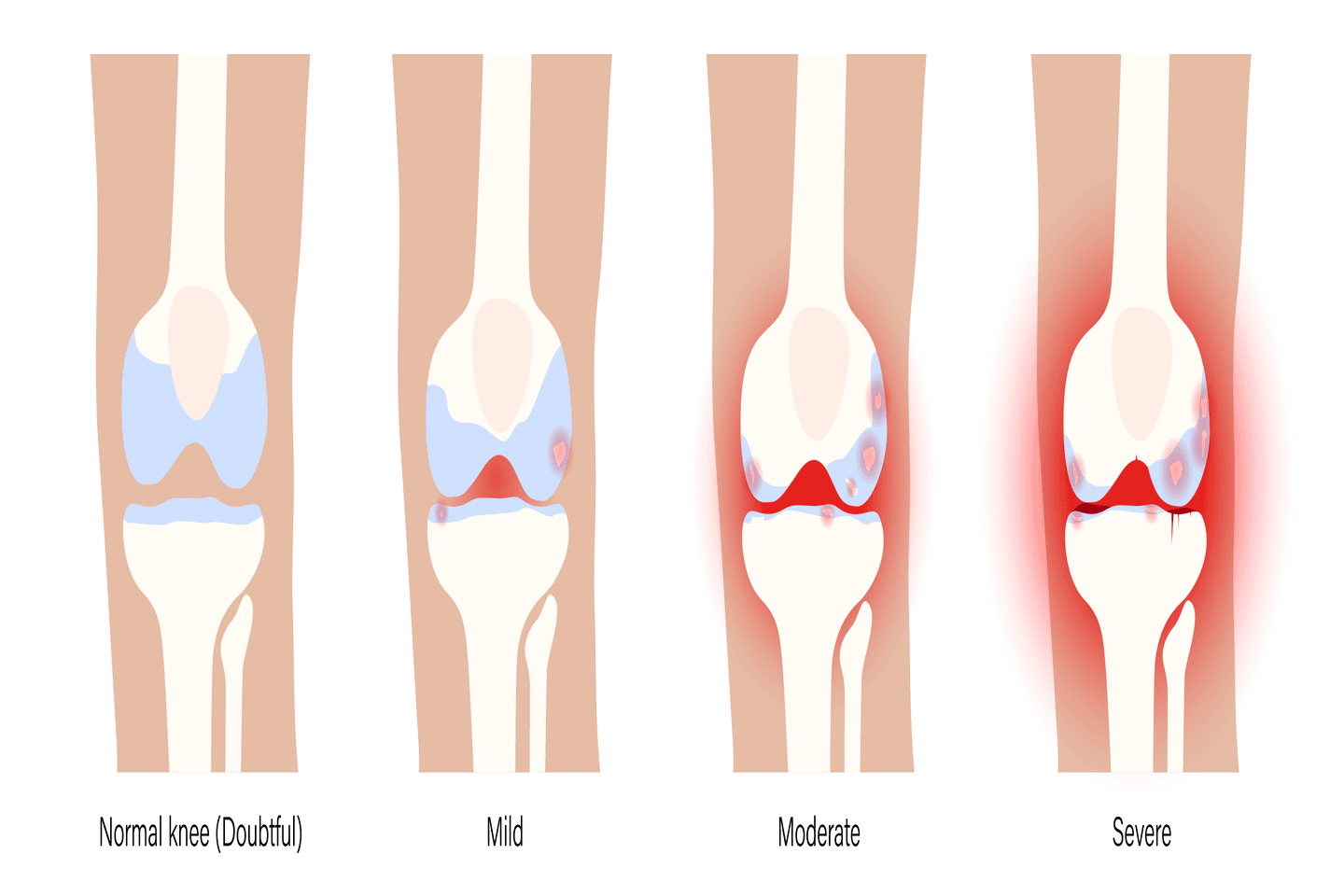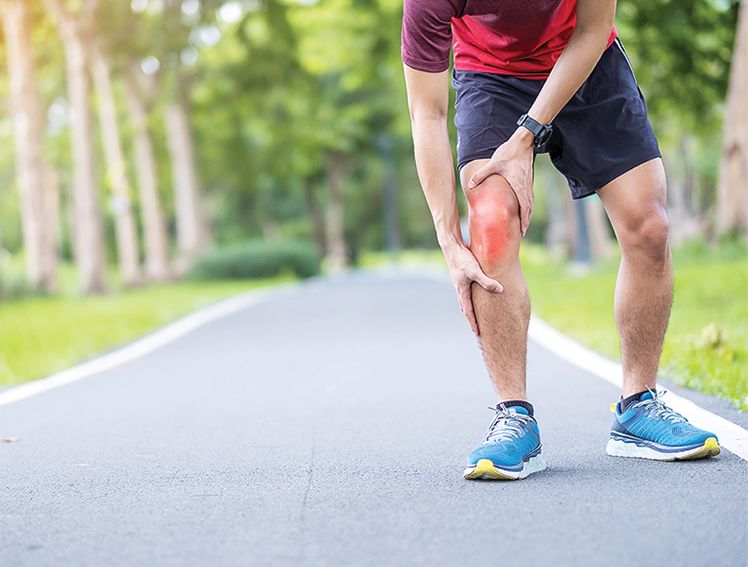
Osteoarthritis vs rheumatoid arthritis: how are they different?
What is osteoarthritis?
Osteoarthritis is the most common form of arthritis, affecting over 32.5 million adults in the United States alone.[1] Think of osteoarthritis as your joints "wearing out" over time - like how the tread on your car tires gradually wears down with use. In osteoarthritis, the smooth, slippery tissue called cartilage that cushions your joints gradually breaks down and wears away.[1] This cartilage normally acts like a shock absorber between your bones, but when it deteriorates, your bones start rubbing against each other during movement.[1] While osteoarthritis can affect any joint in your body, it most commonly develops in joints that bear weight or get used frequently - your knees, hips, hands (especially fingers), and spine.[1][2]
How do you know if you have osteoarthritis?
Symptoms typically develop gradually over months or years. You might notice:
Joint pain that worsens with activity - This is usually the first symptom most people experience. The pain might start as mild discomfort after exercise or activity and gradually become more frequent.
Morning stiffness that improves with movement - Your joints might feel stiff and hard to move when you first wake up, but this usually gets better within 30 minutes of moving around.
Reduced flexibility - You might notice you can't bend or straighten your joints as far as you used to, making daily activities like climbing stairs or opening jars more difficult.
Joint sounds - You might hear crackling, grinding, or popping sounds when you move your joints. While this can sound concerning, it's usually painless and common in osteoarthritis.
Swelling and tenderness - Your joints might feel swollen or tender to touch, especially after periods of increased activity.
Bone spurs - Small, hard lumps might develop around affected joints, though these aren't always noticeable or painful.
What is rheumatoid arthritis?
Rheumatoid arthritis is a chronic autoimmune condition that affects about 1.3 million Americans[3], with women being three times more likely to develop it than men.[4] Unlike osteoarthritis, which is caused by wear and tear, rheumatoid arthritis occurs when your immune system - which normally protects you from infections - mistakenly attacks your own healthy joint tissue.[3]
How does this happen?
Think of your immune system as your body's security force. Normally, it sends special proteins called antibodies to fight off harmful invaders like bacteria and viruses. In rheumatoid arthritis, this security system gets confused and starts attacking the lining of your joints (called synovium) as if it were a dangerous invader.[3]
What makes RA different:
This immune system attack causes inflammation that affects multiple joints at the same time, typically in a symmetrical pattern (meaning both sides of your body). Over time, this chronic inflammation can damage cartilage, bone, and other joint structures, potentially leading to joint deformity if not properly treated.[3]
While there is no remedy for rheumatoid arthritis, physiotherapy and medicines can help slow the progression of the disease.
The symptoms of RA include:
- Pain, swelling and tenderness in multiple joints
- Pain and stiffness in joints on either side of the body
- You may also experience fever, fatigue, and weakness
- Poor appetite
- Weight loss
- Sweating
Inflammation that results in chest pain and dry eyes
Feeling tired and lacking energy
If you have RA, you are also at risk of developing other health complications, like:
- Osteoporosis: a condition that makes the bones weak and brittle.
- Carpal tunnel syndrome: a condition that causes numbness, weakness and tingling in the hand and forearm.
- Inflammation in other parts of the body like lungs, heart, eyes, and blood vessels.
- Joint damage
- Heart disease
- Cervical myelopathy: a disorder affecting the spine.
- Lymphoma: a cancer of the lymphatic system ( the germ fighting network of the body)
- Sjogren's syndrome: an autoimmune disorder that causes dry eyes and mouth, and dry skin.
What is the difference between osteoarthritis and rheumatoid arthritis?
| Factor | Osteoarthritis | Rheumatoid Arthritis |
| Underlying cause | Osteoarthritis is a "wear and tear" condition - like a machine that gradually breaks down with use over time. | Rheumatoid arthritis is an autoimmune disease - your body's defense system attacking your own joints. |
| Age of onset | Osteoarthritis typically develops after age 50, though it can occur earlier with injury or overuse. | Rheumatoid arthritis often starts between ages 30-50, but can occur at any age, including children. |
| Pattern of joint involvement | Osteoarthritis usually affects larger, weight-bearing joints (knees, hips) and frequently used joints (hands, spine), often developing asymmetrically (one side more than the other). | Rheumatoid arthritis typically affects smaller joints first (fingers, toes, wrists) in a symmetrical pattern (both sides equally). |
| Symptom timing | Osteoarthritis pain usually worsens with activity and improves with rest. Morning stiffness lasts less than 30 minutes. | Rheumatoid arthritis often causes more pain and stiffness in the morning and after periods of rest, with morning stiffness usually lasting over an hour. |
| Systemic effects | Osteoarthritis primarily affects joints only. | Rheumatoid arthritis is a whole-body disease that can affect your heart, lungs, eyes, and other organs, causing fatigue, fever, and general illness feelings. |
Risk Factors
Risk factors that increase your likelihood of developing these conditions:
For Osteoarthritis:[5]
Age - Your risk increases significantly after age 50, as joint cartilage naturally breaks down over decades of use.
Gender - Women are more likely to develop osteoarthritis, especially after menopause, possibly due to hormonal changes affecting cartilage health.
Weight - Each extra pound of body weight adds about 4 pounds of pressure to your knees. Being overweight significantly increases stress on weight-bearing joints.
Joint Injuries - Previous injuries from sports, accidents, or repetitive work activities can lead to osteoarthritis years later.
Genetics - Having family members with osteoarthritis increases your risk, suggesting some people inherit a tendency toward cartilage breakdown.
Joint overuse - Jobs or activities that involve repetitive joint stress over many years can contribute to the premature wear of cartilage.
For Rheumatoid Arthritis:[6]
Gender and hormones - Women are 3 times more likely to develop RA, and changes during pregnancy and menopause suggest that hormones play a role in the risk
Genetics - Certain genes (like HLA-DR4) increase susceptibility, though having these genes doesn't guarantee you'll develop RA.
Environmental triggers - Infections, smoking, and exposure to certain substances may trigger RA in genetically susceptible people.
Age - While RA can start at any age, onset is most common between ages 30-60
Treatment for Osteoarthritis and Rheumatoid Arthritis
There is currently no cure for either type of arthritis, nor is there a way to counter joint damage that has already occurred. Both diseases' treatments aim to alleviate pain and improve joint function. The primary goal of RA treatment is to slow down the disease progression and for your body to function against its own interests. Pain medications, using heat or ice to soothe pain, exercise, and weight loss (if needed for osteoarthritis) are usually recommended. For both disorders, joint replacement surgery may be needed.
Meril Life offers the OPULENT GOLD KNEE for Total Knee Replacement required by patients who have osteoarthritis and rheumatoid arthritis. For young and old patients who need to undergo knee replacement surgery or knee arthroplasty, this knee implant system can give them the ability to be active again and regain their quality of life.
Final note
Early detection is key to counter further joint damage in the case of osteoarthritis and rheumatoid arthritis. Both types of arthritis have some similarities, but the primary difference is that RA is an autoimmune disorder while OA is a degenerative joint disorder



